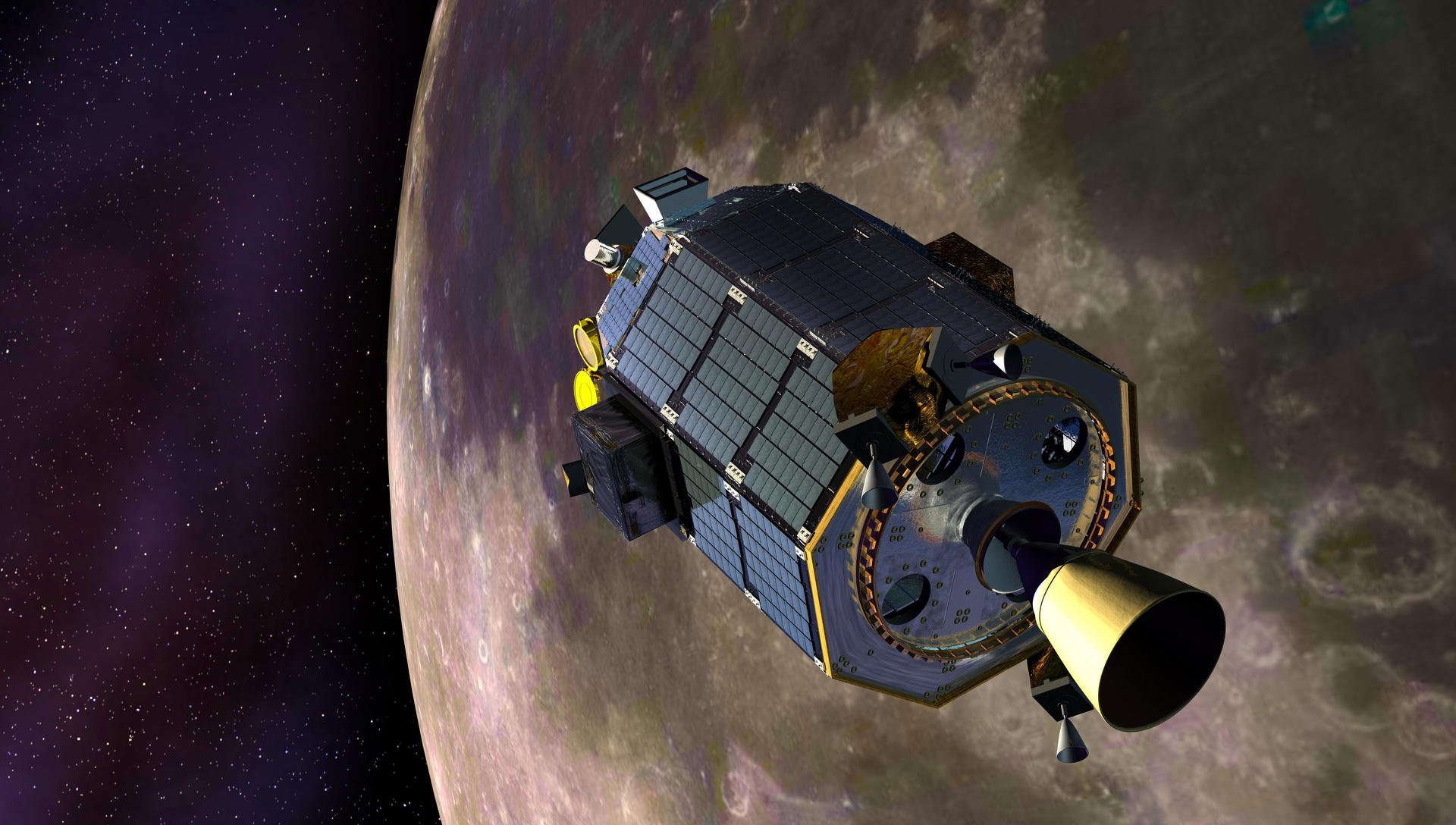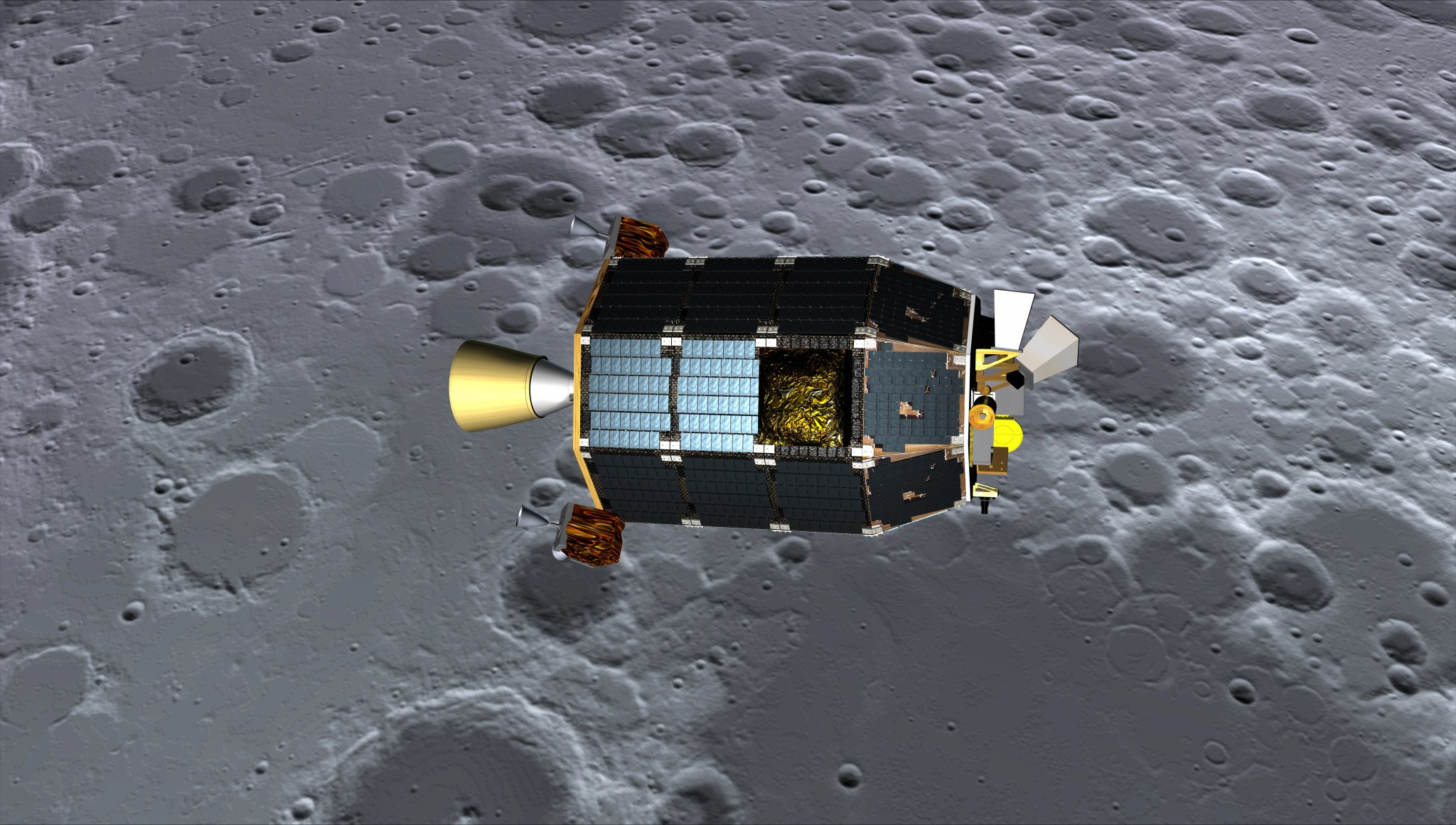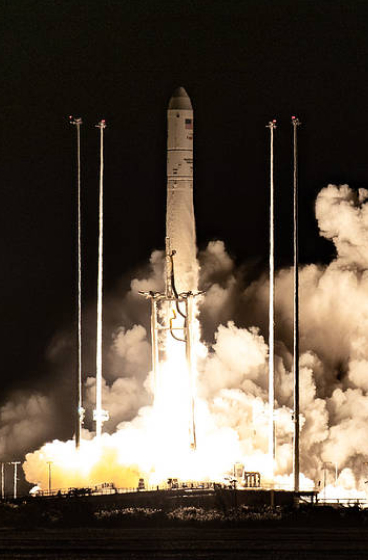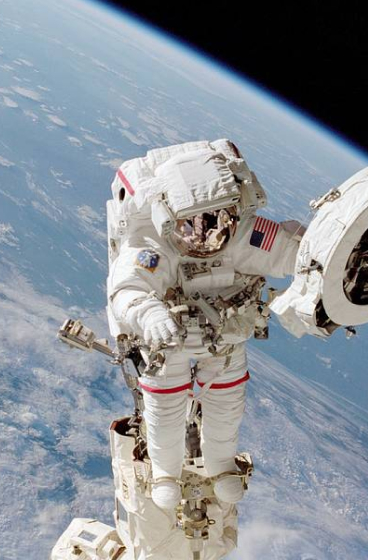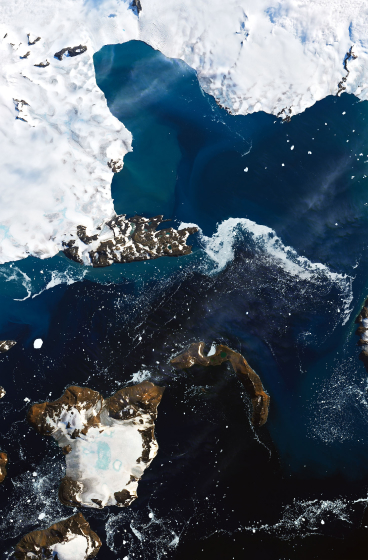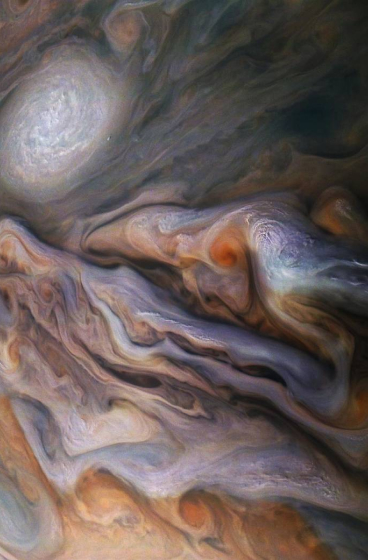Outcome
What We Learned From LADEE
LADEE spacecraft gathered detailed information about the ultra-thin lunar atmosphere, where it comes from, how it changes, and what that means for the Moon’s surface and resources.
Once the presence of significant amounts of water ice on the Moon had been confirmed by NASA’s LCROSS and LRO missions, scientists had to wonder, Where did it come from, how long has it been there, and will it last? To understand better the lunar surface and the resources it holds, researchers needed to know more about the environment the Moon exists in – that is, about the almost non-existent atmosphere that surrounds it.
Just one 25-trillionth the density of Earth’s atmosphere, the envelope of gases held to the Moon by its gravity is so thin and tenuous that it goes by another name, exosphere. Here, molecules in the air are so few and far between, they rarely come into contact with one another. Still, the gases found around the Moon do have important effects on conditions near the surface. This was the focus of NASA’s Lunar Atmosphere and Dust Environment Explorer, or LADEE.
LADEE orbited the Moon for about six months, gathering detailed information about what makes up the delicate lunar atmosphere, its structure, and how it changes. To understand the Moon’s exosphere, we also need to know about the processes controlling it. These include the effects of meteor showers, the solar wind that bombards the Moon with charged particles, and exposure to the Sun’s ultraviolet radiation at the surface.
Understanding how these factors modify the exosphere also allows researchers to work backward to a picture of its original state. Since exospheres are the most common type of atmosphere in our solar system – they surround the planets Pluto and Mercury, icy moons of the outer solar system, asteroids and more – what we learn from examining the Moon’s exosphere can be applied to these other nearly airless places, too. That will help show us how our solar system formed and is changing over time.
Origin of the Moon’s Water
The LADEE mission revealed that tiny meteoroids contribute to the Moon’s exosphere, including by delivering it water. Like bugs on a car windshield, these grains of rocky material traveling through space pelt the lunar surface almost constantly as the Moon makes its way around the Sun. On Earth, they burn up in the atmosphere as meteors, but with the almost negligible atmosphere on the Moon, the particles smash into the surface with tremendous speed. Although the grains are mostly smaller than the head of a pin, they can hit at speeds greater than 21 miles per second, releasing immense heat and vaporizing part of the soil and the meteoroids themselves. The resulting gases can then enter the lunar atmosphere.
When the number of these impacts went up – for instance, if the Moon passed through a relatively dense stream of micrometeoroids – LADEE’s instruments recorded a corresponding increase in certain gases in the exosphere. Researchers used that data to study what the fate of these additional materials might be: Would they fly off into space? Or, heated by the Sun, would they hop around the lunar surface? Based on the data, they thought that molecules like water vapor, randomly bouncing across the surface, could potentially migrate to permanently shadowed regions at the poles. There, it’s so cold that molecules slow almost to a halt and get stuck.
Researchers are still studying how the reservoir of water ice spread across the Moon’s poles got there. But, regardless of its origin, it’s an important resource that could be harvested right from the lunar surface to produce fuel, water, and air for future missions.
Moon Dust
Moon dust is so abrasive it caused a lot of wear on the Apollo spacesuits in a short amount of time. It also built up quickly in joint areas – for example, where the gloves connect to the suit – making them difficult to engage. A better understanding of material floating in the lunar atmosphere will help design the next generation of suits and equipment for the Moon’s surface.
In addition to gases, LADEE found the micrometeoroid particles striking the surface also eject lunar dust. Each particle impact sends up a spray of debris, resulting in a thin cloud of small dust particles over the area of the Moon affected.
Addressing a longstanding mystery from the Apollo era was also on LADEE’s to-do list. Astronauts in orbit around the Moon reported seeing a glow on the horizon before sunrise. One possible explanation was that lunar dust, electrically charged by the Sun’s ultraviolet light, was levitating above the surface. However, the spacecraft’s instruments found no evidence of any effect that could be seen by the human eye.
Gases of the Lunar Exosphere
Scientists learned that the major components of the thin lunar atmosphere are helium, neon, and argon. The presence of neon had been a subject of speculation since Apollo, and LADEE finally confirmed it.
To understand where the neon comes from, one of LADEE's instruments systematically measured these gases and we now know that it is supplied by the solar wind. The solar wind is a stream of gas blowing from the surface of the Sun into space at around a million miles per hour.
The argon comes largely from the natural transformation of a radioactive form of potassium found in the rocks of all the terrestrial planets. As the Moon’s potassium decays – the term for the way radioactive material changes over time – the resulting argon percolates up to the lunar surface, where it becomes part of the tenuous atmosphere.Like neon, the third main lunar gas, helium, comes largely from the solar wind, though may also have some contribution from radioactive decay. Scientists compared LADEE’s data to data from another NASA mission, ARTEMIS, which measured the input from the solar wind. They learned that the amount of helium in the lunar exosphere is closely tied to the amount of input from the solar wind, and that the residence time (or how long each individual atom sticks around on the Moon) for helium is just a few days. It is longer for neon and argon because they are bigger atoms, so it’s more difficult for them to escape.
FAQ: LADEE’S Planned Impact
Note: This FAQ was created before the LADEE mission ended.
What is LADEE?
Launched in September 2013, from NASA's Wallops Flight Facility on Wallops Island, V\irginia, the Lunar Atmosphere and Dust Environment Explorer (LADEE) is a robotic vending-machine size spacecraft that has been orbiting the Moon since Oct. 6. On Nov. 10, LADEE began gathering science data, and on Nov. 20, the spacecraft entered its science orbit around the Moon's equator. LADEE has been in extended mission operations following a highly successful 100-day primary science phase.
Scientists hope to address a long-standing question: Was lunar dust, electrically charged by sunlight, responsible for the pre-sunrise glow detected during several Apollo missions above the lunar horizon? LADEE also is gathering detailed information about the structure and composition of the thin lunar atmosphere.
A thorough understanding of these characteristics of our nearest celestial neighbor will help researchers understand other bodies in the solar system, such as large asteroids, Mercury, and the Moons of outer planets.
NASA's Science Mission Directorate in Washington funds the LADEE mission. Ames has been responsible for spacecraft design, development, testing and mission operation, in addition to managing the overall mission. Goddard manages the science instruments and technology demonstration payload, the science operations center and provides mission support. Wallops is responsible for launch vehicle integration, launch services and operations. NASA's Marshall Space Flight Center in Huntsville, Ala., manages LADEE within the Lunar Quest Program Office.
How low is the LADEE spacecraft orbiting the Moon?
The LADEE spacecraft is gradually lowering its orbital altitude to continue making science observations prior to its planned impact on the Moon’s surface on or before April 21, 2014. Ground controllers at NASA's Ames Research Center in Moffett Field, Calif., are maneuvering the spacecraft to fly approximately 1 to 2 miles (2 to 3 kilometers) above the lunar surface to gather science measurements at the lowest altitude possible.
When is the LADEE mission scheduled to impact the Moon? Is it planned?
Yes, NASA plans to impact the LADEE spacecraft into the surface of the far side of the Moon on or before April 21, 2014.
If LADEE impacts before April 21, would some consider that a failure?
LADEE has achieved full mission success, meeting all goals and objectives early in March, 2014. Additional science data are being acquired even now, while LADEE swoops low over the lunar terrain. This extra science is a bonus, far more than is required or was originally designed for. An early impact, while unlikely, would not affect the complete success of the mission.
Ground controllers have little room for error with LADEE's navigation system, and at these low orbital altitudes, a small error could mean the difference between continuing to orbit above the lunar surface and impacting it. Because of this, the team does not intend to target a specific impact location on the Moon's surface.
The Moon's gravity field is so lumpy, and the terrain is so highly variable with crater ridges and valleys that frequent maneuvers are required or the LADEE spacecraft will impact the Moon’s surface. Even if the spacecraft were to perform all maneuvers perfectly, there's still a chance LADEE could impact the Moon sometime before April 21.
Will the impact destroy the Moon or affect its orbit?
No. The Moon's "face" is a result of impacts throughout the Moon's life. The lunar surface has withstood many impacts by much larger, much faster objects. The Moon is constantly bombarded with meteorites and space debris. On average, the Moon receives a LADEE-sized impact every month.
Will the Moon look different after the impact?
No. The Moon will not look any differently than it does today.
Can I see the impact online? Live on TV?
No one will be able to see anything around the LADEE impact. On April 11, the spacecraft will perform a final maneuver to ensure LADEE's trajectory will impact the far side of the Moon, which is not in view of Earth or near any previous lunar mission landings.
Will the LADEE impact contaminate the Moon?
At the time of impact, the spacecraft will have used all of its fuel. During impact, the LADEE spacecraft will crumple and break apart. Most of the spacecraft’s material will heat up several hundred degrees during impact and stay within about 20 meters of the impact crater. Any unspent rocket fuel (primarily hydrazine) most likely will burn upon impact.
Lunar Prospector scattered human ashes on the Moon's surface when that spacecraft impacted. Are there any ashes on LADEE?
Lunar Prospector carried a small amount of Eugene Shoemaker's ashes to the Moon. Shoemaker was a planetary scientist who contributed greatly to our understanding of the Moon. He died in an auto accident in 1997. Some of his ashes were carried to the Moon as a tribute to his lifetime of outstanding work. Since then, NASA has become more aware of the importance of the Moon has to people of many cultures. Because of this new appreciation of various cultures, LADEE will not carry human remains.
Will the Hubble Space Telescope or any Earth-based telescopes be able to see the impact?
No. The LADEE project anticipates that the spacecraft's impact won't be bigger than those of Ebb and Flow spacecraft (part of the GRAIL mission), which were invisible even to a sensitive Infrared imaging radiometer aboard NASA's Lunar Reconnaissance Orbiter.
Are there plans to search for the LADEE impact site?
Yes, NASA's Lunar Reconnaissance Orbiter may be able to find the LADEE impact site in the coming months.
How close to the lunar surface did LADEE orbit?
In its previous orbit - during the 100-day science operations phase - LADEE's closest approach to the lunar surface was between 12.5 and 31 miles (20 and 50 kilometers), and its farthest was between 47 and 93 miles (75 and 150 kilometers)
What happens to the LADEE observatory after the mission ends?
The spacecraft will impact the Moon as it does not have enough fuel to escape its lunar orbit.

























